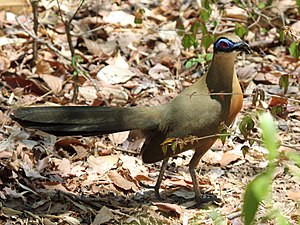Coquerel silk cuckoo
| Coquerel silk cuckoo | ||||||||||||
|---|---|---|---|---|---|---|---|---|---|---|---|---|

Coquerel's silk cuckoo ( Coua coquereli ) |
||||||||||||
| Systematics | ||||||||||||
|
||||||||||||
| Scientific name | ||||||||||||
| Coua coquereli | ||||||||||||
| Grandidier , 1867 |
The Coquerel silk cuckoo ( Coua coquereli ) is a species of bird from the genus of the silk cuckoo ( Coua ) endemic to the island of Madagascar . The type epithet honors the French naturalist Charles Coquerel (1822–1867).
features
The Coquerel silk cuckoo reaches a size of 42 centimeters. The sexes look the same. In the adult birds, the top and the wings are olive green with a dull bronze-colored wash. The tail is dark bronze. The face is black. The underside, throat and chest are whitish to beige. The underbust is tan purple. The belly and the underside of the tail are olive gray. The underside of the tail feathers is black. The outer tail feathers have white tips. The bare skin around the eyes is tri-colored. Above the eyes it is sky blue, behind the eyes it is dark blue and shimmering pink-purple behind the blue area of the skin, which is bordered by black feathers. The iris is surrounded by a blue eye ring. The beak, legs and feet are black.
In juvenile birds, the skull is gray. The plumage is more blunt than that of the adult birds. The wing covers are brown with tan edges. The hand and arm wings have tan tips and a black subterminal band. The tail and tail feathers are colored like those of the adult birds. The underside is banded whitish and darker gray. The skin around the eyes is dull blue without the black feather border of the adult birds. The iris is dark brown. The beak is light flesh-colored, the ridge of the beak is sepia-colored. Legs and feet are gray.
When hatching, the nestlings are featherless and fluffless. The skin is purple black. The beak is bright reddish. The palate is bright pink.
Vocalizations
The voice consists of loud, clear rows of two to four whistles followed by a deep, soft, rolling, growling “weerweer-weer”. In addition, a few higher tones can be heard in a longer lasting “weer-weer-weer-wink-wink”, grunts and growls and a high-pitched “ayoo-ew”.
habitat
The Coquerel silkworm inhabits the edges of semi-deserts, dry forests, as well as moist forests with limited ground vegetation. It is less common in secondary forests. It occurs in regions from sea level to at altitudes of 1000 meters.
Distribution and Status
The Coquerel silky cuckoo is quite common in north and northwest Madagascar. There are larger populations at Ampijoroa, in the Kirindy Forest and at Zombitse. It is a shy bird as it is hunted in many areas. The IUCN classifies it in the category not at risk (least concern).
Way of life
The Coquerel's silky cuckoo hunts for food on paths on the forest floor and in the middle layers of the tree at a height of one to five meters. The diet consists of insects, including grasshoppers, caterpillars, moths, beetles and spiders, as well as fruits and seeds.
The eggs are laid between November and January. The bowl-shaped nest consists of twigs, small branches, petioles and bark. It has a circumference of 16 centimeters and is 13 centimeters high. The nests are erected at a height of three to eight meters either in lianas or on the trunk of a tree. The clutch consists of two to three dull white eggs measuring 33.5 × 25 mm. The length of the breeding and nestling periods is unknown.
The Coquerel Silky Cuckoo is a monogamous bird that is loyal to its location and can often be seen in pairs.
literature
- Robert B. Payne: The Cuckoos. Bird Families of the World. Volume 15 , Oxford University Press, 2005 ISBN 0-19-850213-3
Individual evidence
- ↑ Coua coquereli in the endangered Red List species the IUCN 2012. Posted by: BirdLife International, 2012. Accessed October 31, 2012th